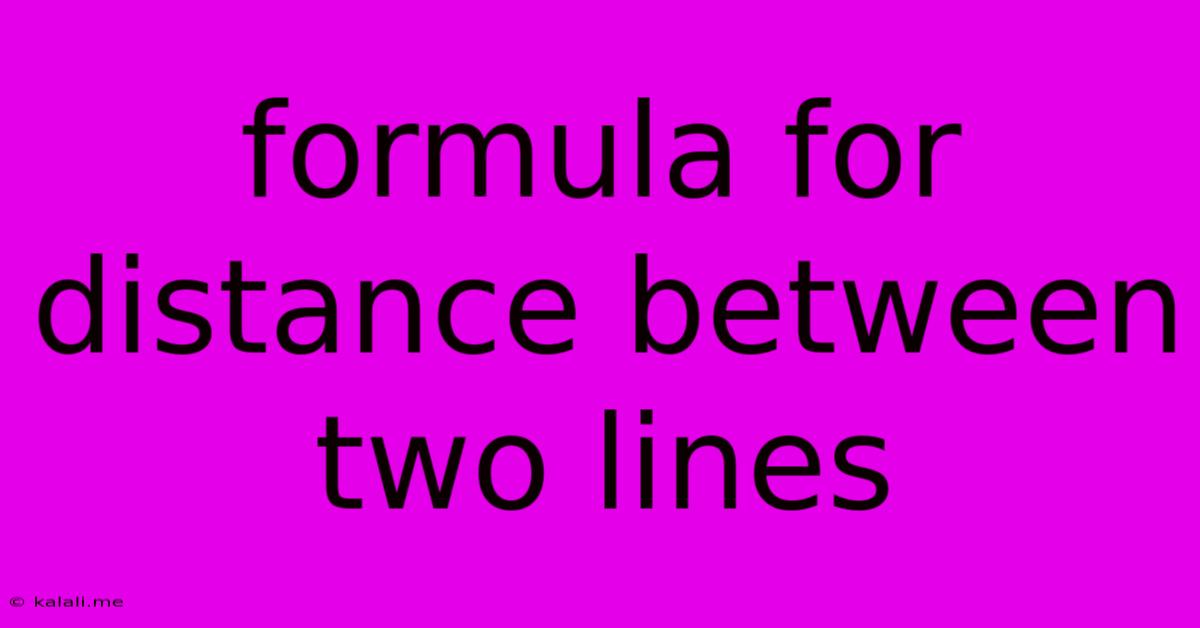Formula For Distance Between Two Lines
Kalali
Jun 13, 2025 · 3 min read

Table of Contents
The Formula for the Distance Between Two Lines
Finding the distance between two lines is a fundamental concept in geometry with applications in various fields, including computer graphics, physics, and engineering. This article will explore the different scenarios and provide you with the formulas and methods to calculate this distance accurately. Understanding this will allow you to solve a variety of geometric problems efficiently.
The method for calculating the distance depends on whether the lines are parallel or intersecting. Let's break down both scenarios.
Distance Between Two Parallel Lines
The most straightforward case is calculating the distance between two parallel lines. Assume we have two parallel lines defined by the equations:
- Line 1: Ax + By + C₁ = 0
- Line 2: Ax + By + C₂ = 0
Where A, B are constants defining the slope and orientation of the lines, and C₁ and C₂ are constants representing the y-intercept. Note that because the lines are parallel, the coefficients A and B are identical for both lines.
The formula for the distance (d) between these two parallel lines is:
d = |C₁ - C₂| / √(A² + B²)
This formula is derived from the perpendicular distance from a point to a line. The absolute value ensures the distance is always positive.
Example: Find the distance between the lines 2x + 3y - 6 = 0 and 2x + 3y + 9 = 0.
Here, A = 2, B = 3, C₁ = -6, and C₂ = 9. Plugging these values into the formula:
d = |-6 - 9| / √(2² + 3²) = 15 / √13
Therefore, the distance between the two lines is 15/√13 units.
Distance Between Two Intersecting Lines
Calculating the distance between two intersecting lines is slightly more complex. Since intersecting lines extend infinitely, there's no single "distance" between them. Instead, we often consider the shortest distance between the two lines, which is the length of the line segment connecting the lines and perpendicular to both. This concept is closely related to the shortest distance between two skew lines in 3D space.
Unfortunately, there isn't a single concise formula for this, but the approach generally involves:
-
Finding the point of intersection: Solve the system of equations representing the two lines to find the coordinates of their intersection point. If the lines are parallel, there is no intersection point, and we use the method described in the previous section.
-
Finding the direction vectors: Determine the direction vectors of both lines. These vectors represent the direction in which the lines extend.
-
Calculating the shortest distance: Use vector projection or cross products to calculate the shortest distance between the two lines. This involves finding a vector connecting the lines and is perpendicular to both lines. The magnitude of this vector is the shortest distance.
This method requires a strong understanding of vector algebra and is generally more suitable for solving with advanced mathematical tools or software. Detailed explanations of this process require a much deeper dive into linear algebra and vector geometry than can be covered comprehensively here.
Conclusion
Calculating the distance between two lines hinges on whether they are parallel or intersecting. Parallel lines offer a simple formula using the coefficients of their equations. Intersecting lines require more advanced vector algebra techniques to determine the shortest distance. Understanding these approaches provides essential tools for solving problems involving lines in various geometric and applied contexts. Remember to choose the appropriate method based on the relationship between the lines in question.
Latest Posts
Latest Posts
-
An Electron Is Accelerated From Rest Through A Potential Difference
Jun 14, 2025
-
Greater Than Less Than Calculator Decimals
Jun 14, 2025
-
What Are Two Elements That Are Liquid At Room Temperature
Jun 14, 2025
-
Gpa Requirements For Valdosta State University
Jun 14, 2025
-
At What Temperature Do Celsius And Fahrenheit Scales Coincide
Jun 14, 2025
Related Post
Thank you for visiting our website which covers about Formula For Distance Between Two Lines . We hope the information provided has been useful to you. Feel free to contact us if you have any questions or need further assistance. See you next time and don't miss to bookmark.